Abstract
The in vitro postantibiotic effects (PAE) of aztreonam, ceftazidime, cefuroxime, imipenem, and piperacillin on Escherichia coli ATCC 25922 were studied by a bioluminescence assay of bacterial ATP. In parallel with the PAE investigation, viability and morphology studies were performed. The strain was exposed for 2 h to different concentrations of beta-lactam antibiotics. The antibiotic activity was eliminated by 10(-4) dilutions, and regrowth of bacteria was monitored hourly by the bioluminescence assay of bacterial ATP. The length of PAE was dose dependent for ceftazidime (0.5 to 2.6 h), cefuroxime (0.4 to 2.6 h), and imipenem (0.3 to 4.5 h). The long PAE for these antibiotics at higher concentrations was associated with a potent initial killing and the presence of spheroplasts. Aztreonam and piperacillin produced a short, non-dose-dependent PAE (0.4 to 0.95 h). Short PAEs (below 1 h) were seen concomitantly with production of filaments, except in the case of imipenem, which only produced spheroplasts. The bioluminescence method was not jeopardized by filament formation, in contrast to the viable count assay which is normally used for PAE investigations. This makes it possible to study PAE for beta-lactam antibiotics on gram-negative bacteria with bioluminescence.
Full text
PDF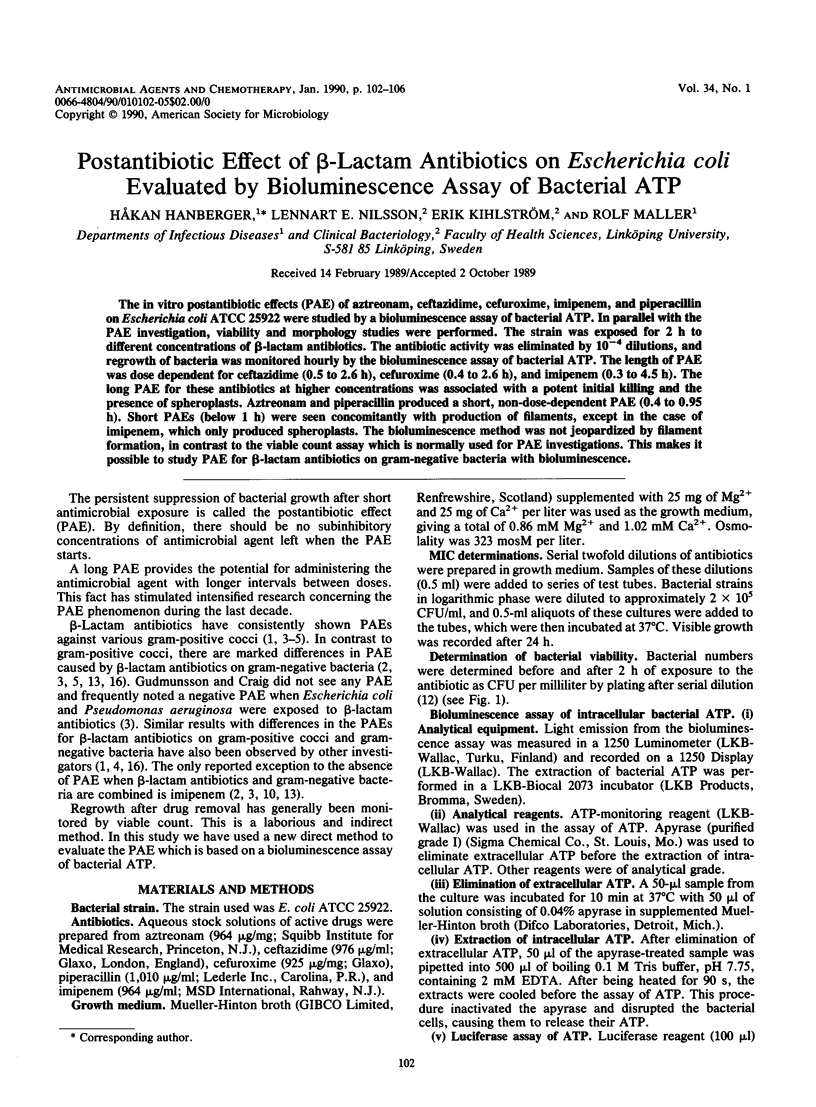
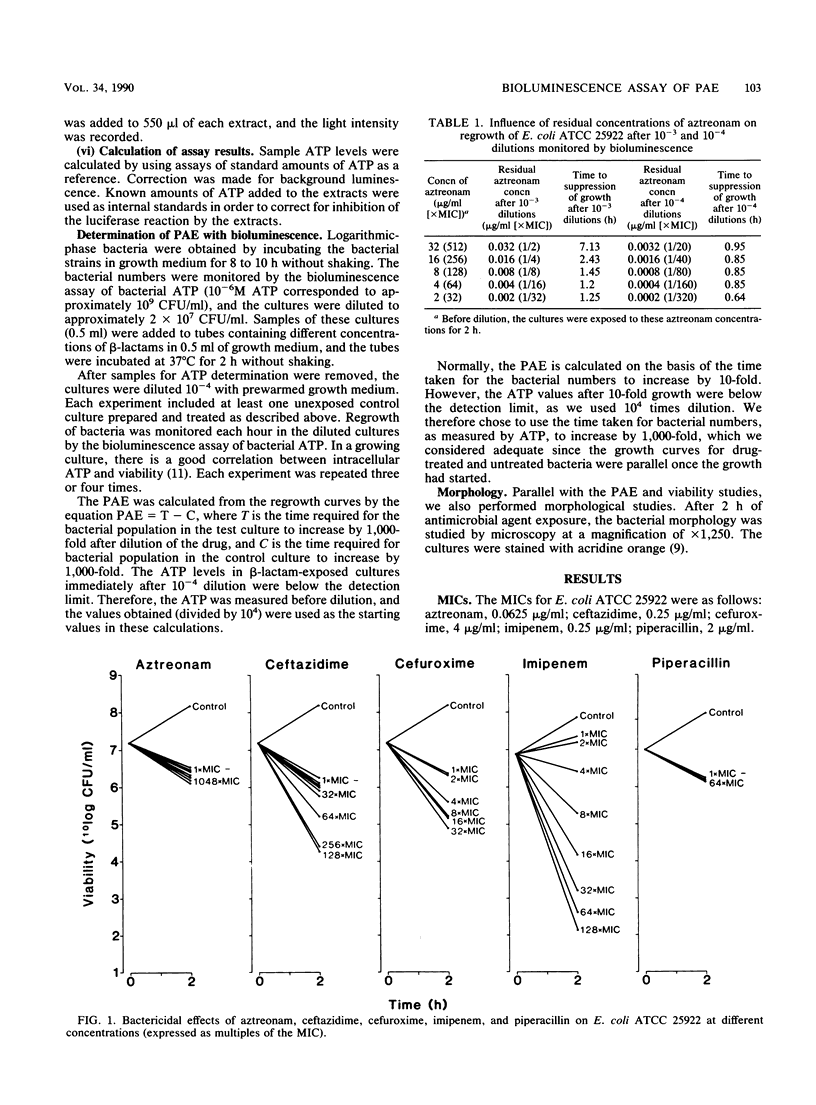
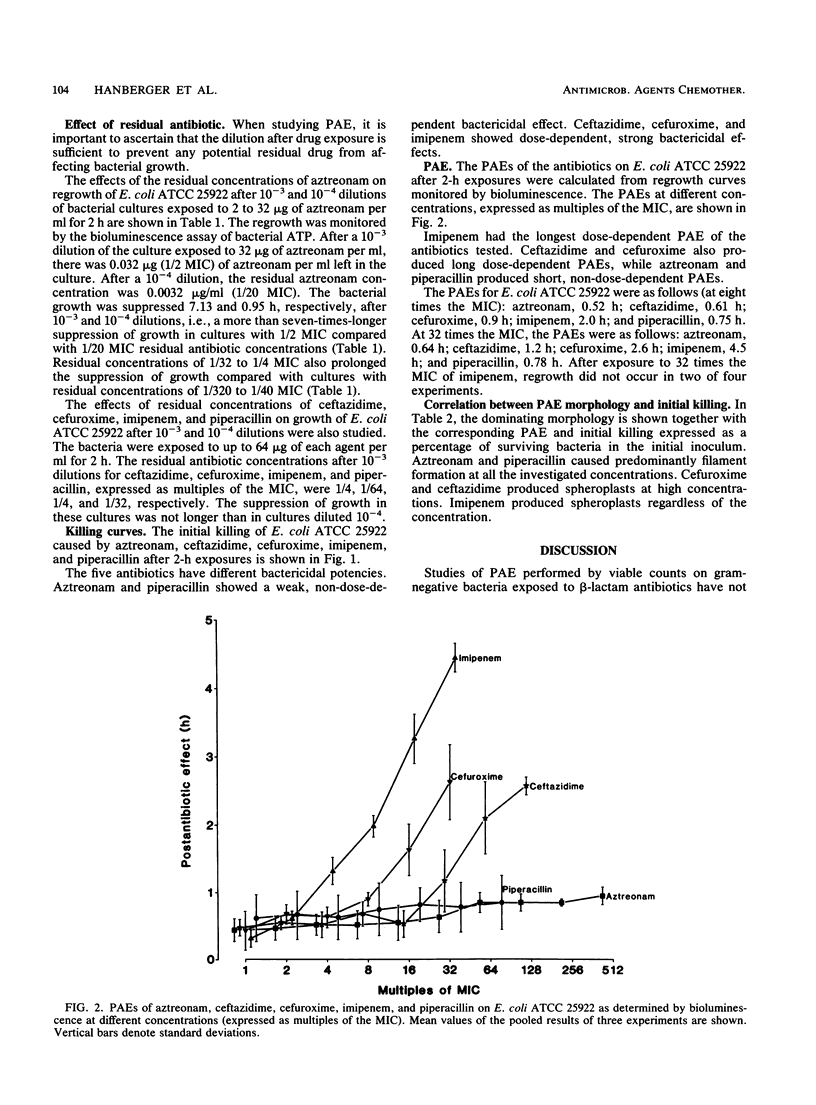
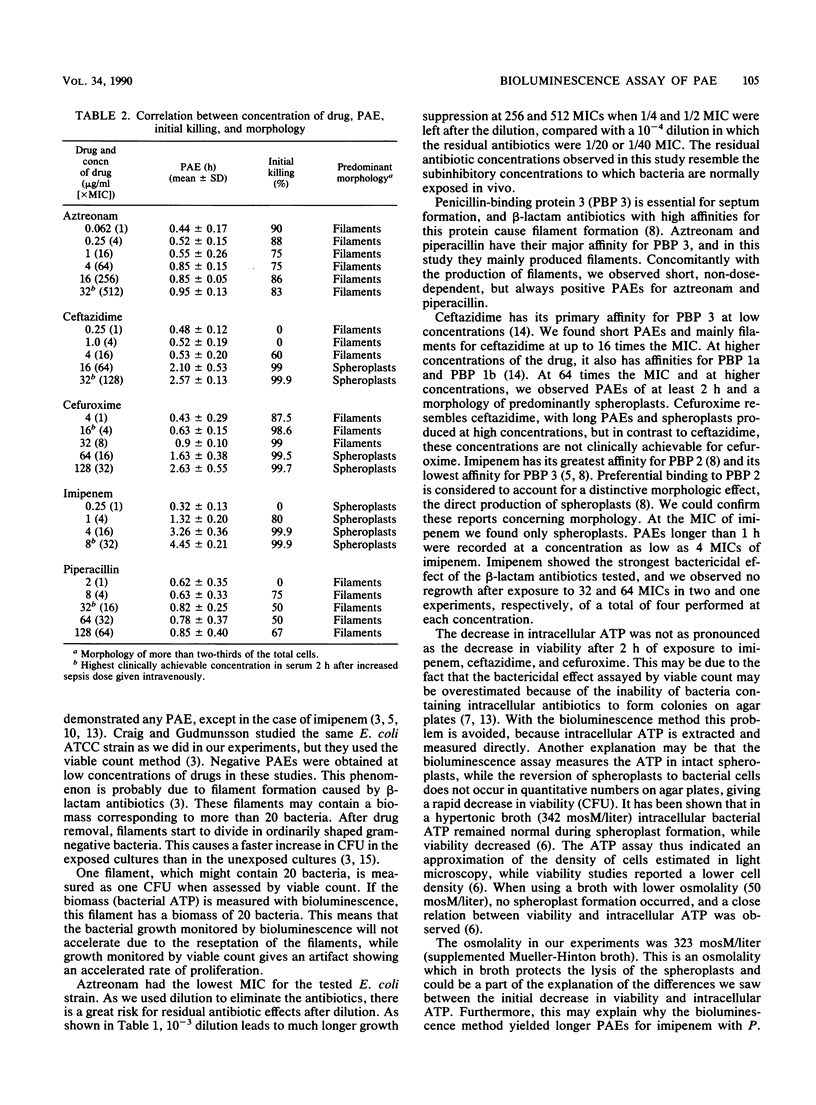
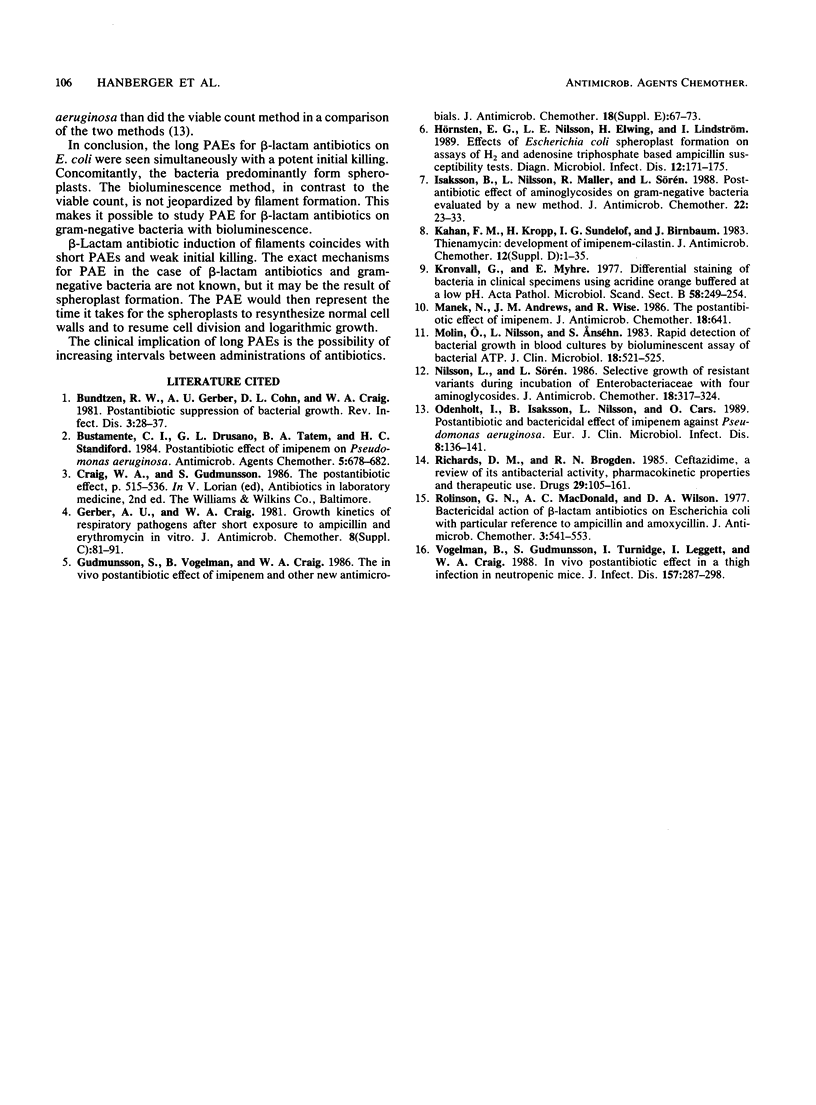
Selected References
These references are in PubMed. This may not be the complete list of references from this article.
- Bundtzen R. W., Gerber A. U., Cohn D. L., Craig W. A. Postantibiotic suppression of bacterial growth. Rev Infect Dis. 1981 Jan-Feb;3(1):28–37. doi: 10.1093/clinids/3.1.28. [DOI] [PubMed] [Google Scholar]
- Bustamante C. I., Drusano G. L., Tatem B. A., Standiford H. C. Postantibiotic effect of imipenem on Pseudomonas aeruginosa. Antimicrob Agents Chemother. 1984 Nov;26(5):678–682. doi: 10.1128/aac.26.5.678. [DOI] [PMC free article] [PubMed] [Google Scholar]
- Gerber A. U., Craig W. A. Growth kinetics of respiratory pathogens after short exposures to ampicillin and erythromycin in vitro. J Antimicrob Chemother. 1981 Nov;8 (Suppl 100):81–91. doi: 10.1093/jac/8.suppl_c.81. [DOI] [PubMed] [Google Scholar]
- Gudmundsson S., Vogelman B., Craig W. A. The in-vivo postantibiotic effect of imipenem and other new antimicrobials. J Antimicrob Chemother. 1986 Dec;18 (Suppl E):67–73. doi: 10.1093/jac/18.supplement_e.67. [DOI] [PubMed] [Google Scholar]
- Hörnsten E. G., Nilsson L. E., Elwing H., Lundström I. Effects of Escherichia coli spheroplast formation on assays of H2 and adenosine triphosphate based ampicillin susceptibility tests. Diagn Microbiol Infect Dis. 1989 Mar-Apr;12(2):171–175. doi: 10.1016/0732-8893(89)90009-6. [DOI] [PubMed] [Google Scholar]
- Isaksson B., Nilsson L., Maller R., Sörén L. Postantibiotic effect of aminoglycosides on gram-negative bacteria evaluated by a new method. J Antimicrob Chemother. 1988 Jul;22(1):23–33. doi: 10.1093/jac/22.1.23. [DOI] [PubMed] [Google Scholar]
- Kahan F. M., Kropp H., Sundelof J. G., Birnbaum J. Thienamycin: development of imipenen-cilastatin. J Antimicrob Chemother. 1983 Dec;12 (Suppl 500):1–35. doi: 10.1093/jac/12.suppl_d.1. [DOI] [PubMed] [Google Scholar]
- Kronvall G., Myhre E. Differential staining of bacteria in clinical specimens using acridine orange buffered at low pH. Acta Pathol Microbiol Scand B. 1977 Aug;85(4):249–254. doi: 10.1111/j.1699-0463.1977.tb01970.x. [DOI] [PubMed] [Google Scholar]
- Manek N., Andrews J. M., Wise R. The postantibiotic effect of imipenem. J Antimicrob Chemother. 1986 Nov;18(5):641–641. doi: 10.1093/jac/18.5.641. [DOI] [PubMed] [Google Scholar]
- Molin O., Nilsson L., Anséhn S. Rapid detection of bacterial growth in blood cultures by bioluminescent assay of bacterial ATP. J Clin Microbiol. 1983 Sep;18(3):521–525. doi: 10.1128/jcm.18.3.521-525.1983. [DOI] [PMC free article] [PubMed] [Google Scholar]
- Nilsson L., Sörén L. Selective growth of resistant variants during incubation of Enterobacteriaceae with four aminoglycosides. J Antimicrob Chemother. 1986 Sep;18(3):317–324. doi: 10.1093/jac/18.3.317. [DOI] [PubMed] [Google Scholar]
- Odenholt I., Isaksson B., Nilsson L., Cars O. Postantibiotic and bactericidal effect of imipenem against Pseudomonas aeruginosa. Eur J Clin Microbiol Infect Dis. 1989 Feb;8(2):136–141. doi: 10.1007/BF01963897. [DOI] [PubMed] [Google Scholar]
- Richards D. M., Brogden R. N. Ceftazidime. A review of its antibacterial activity, pharmacokinetic properties and therapeutic use. Drugs. 1985 Feb;29(2):105–161. doi: 10.2165/00003495-198529020-00002. [DOI] [PubMed] [Google Scholar]
- Rolinson G. N., Macdonald A. C., Wilson D. A. Bactericidal action of beta-lactam antibiotics on Escherichia coli with particular reference to ampicillin and amoxycillin. J Antimicrob Chemother. 1977 Nov;3(6):541–553. doi: 10.1093/jac/3.6.541. [DOI] [PubMed] [Google Scholar]
- Vogelman B., Gudmundsson S., Turnidge J., Leggett J., Craig W. A. In vivo postantibiotic effect in a thigh infection in neutropenic mice. J Infect Dis. 1988 Feb;157(2):287–298. doi: 10.1093/infdis/157.2.287. [DOI] [PubMed] [Google Scholar]


